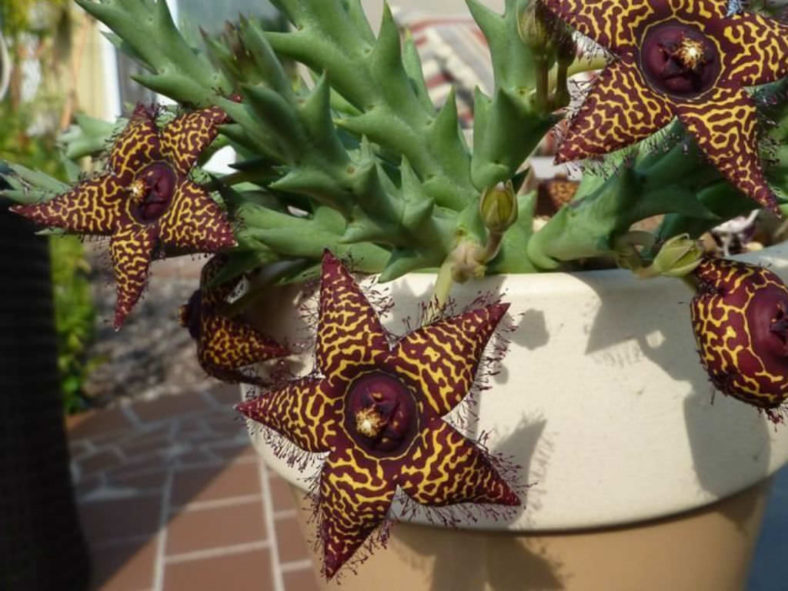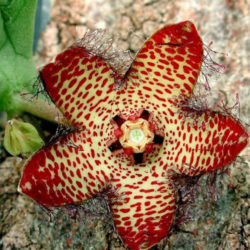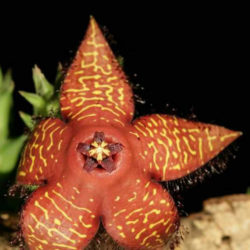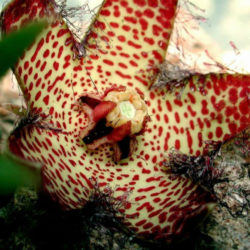Scientific Name
Orbea macloughlinii (Verdc.) L.C. Leach
Synonym(s)
Ceropegia macloughlinii, Ceropegia mcloughlinii, Orbea mcloughlinii, Stapelia macloughlinii, Stapelia mcloughlinii
Scientific Classification
Family: Apocynaceae
Subfamily: Asclepiadoideae
Tribe: Ceropegieae
Subtribe: Stapeliinae
Genus: Orbea
Description
Orbea macloughlinii, also known as Orbea mcloughlinii, is a dwarf succulent plant that forms a small clump of slender, pale green, erect to shortly decumbent stems flecked with purple-brown. The stems can grow up to 4 inches (10 cm) long and 0.3 inches (0.8 cm) thick (excluding teeth). They have tubercles arranged into four rows along the stem with slight grooves between rows. The tubercles are up to 0.4 inches (1 cm) long, tapering into slender, spreading conical teeth.
In late summer and fall, the plant produces inflorescences, one per stem near the base, of 1 to 3 attractive flowers developing in gradual succession. The star-shaped flowers have five slightly reflexed lobes and can reach a diameter of 2.2 inches (5.5 cm). The corolla lobes are smooth, dark maroon to brown-red with few to many irregular, yellow transverse markings towards the tips or with maroon spots on a yellow background. The corona is raised well above the base of the tube on a dark maroon pentagonal stipe. The outer lobes are dark maroon, while the inner lobes are yellow minutely speckled with red.
Origin
Orbea macloughlinii is native to South Africa. It grows in dry places in shallow soils in the former Transkei in the Eastern Cape and a single locality in southern KwaZulu-Natal.
Etymology
The specific epithet "macloughlinii (mak-lowh-LIN-ee-eye)" honors Major Alfred George McLoughlin (1886-1960), a South African botanist who worked mainly on orchids and succulents.

Hardiness
USDA hardiness zone 9b to 11b: from 25 °F (−3.9 °C) to 50 °F (+10 °C).
How to Grow and Care
Several species are fairly easy to grow. Others, often those with slightly hairy stems and the more unusual flowers, are more challenging and require careful watering (with some fertilizer) during the growing season and complete water withdrawal during the winter months. A minimum winter temperature of 10°C (50°F) is acceptable, providing the soil is kept dry. A heated growing bench or incubator may help delicate plants get through the colder months. However, many species live under shrubs in their habitat and prefer light shade rather than full sun.
A gritty compost is essential, and clay pots are advisable for the more delicate species. Some growers prefer mineral-only compost to minimize the chance of a fungal attack on the roots. A layer of grit on the compost surface prevents moisture from accumulating around the base of the stems.
Keeping Stapelias and their roots free of pests such as mealybugs is the key to success, as fungal attack often occurs due to damage to stems by insects.
See more at How to Grow and Care for Stapelia.
Links
- Back to genus Orbea
- Succupedia: Browse succulents by Scientific Name, Common Name, Genus, Family, USDA Hardiness Zone, Origin, or cacti by Genus
Photo Gallery
Click on a photo to see a larger version.


